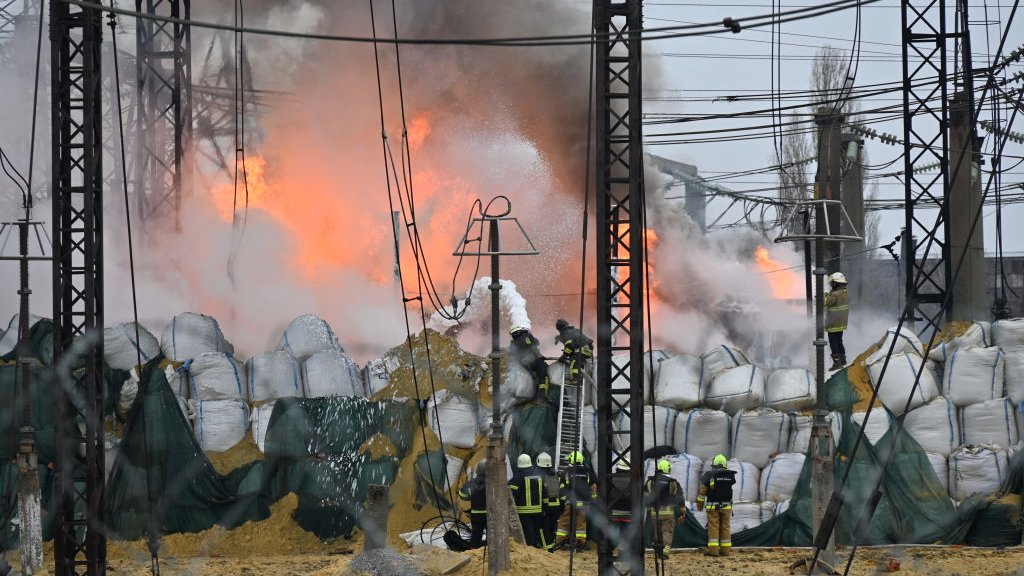Russia Launches Massive Attack on Ukraine’s Energy Grid, Leaving Over a Million Without Power
In a grave escalation of hostilities, Russia has unleashed a comprehensive assault on Ukraine’s energy infrastructure, directly impacting more than a million households. The attack, which utilized over 200 missiles and drones, marks the second major offensive in less than two weeks, underscoring Moscow’s intensified efforts to cripple Ukraine’s essential infrastructure.
The Scale of the Assault
On Thursday, Ukrainian officials reported significant damage to energy facilities nationwide. The Ukrainian Energy Minister, Herman Halushchenko, relayed these developments via a Facebook post, confirming the widespread nature of the attack and the resulting emergency power outages that swept across the country. Affected regions include western Ukraine’s Lviv and Ivano-Frankivsk, alongside the northwestern Rivne and Volyn regions. These relentless strikes not only disrupt daily life but also threaten the stability of the nation’s power supply as winter approaches.
Military Strategy and Objectives
The Russian assault employed Kalibr cruise missiles, which are notorious for their capability to disperse smaller bombs, devastating multiple targets simultaneously. Ukrainian President Volodymyr Zelenskyy characterized these strikes as an “insidious escalation” of aggression. During his address, he highlighted the immediate necessity for advanced air defense systems from Western nations, in order to safeguard civilian lives and preserve critical infrastructure. Zelenskyy emphasized on Telegram, “Each attack like this underscores the urgent need for air defense systems in Ukraine, where they can save lives and prevent devastation, rather than sitting unused at storage facilities.”
The nature of the assault reflects a calculated military strategy aimed at maximizing both civilian and infrastructural casualties while undermining Ukraine’s resilience during the winter months.
Anticipated Continual Attacks
Andrii Yermak, head of the Ukrainian presidential office, suggested that the Russian government is deliberately stockpiling missiles with the intention of ramping up their offensive capabilities through the winter. He implicated “crazy allies” like North Korea, hinting at the potential for further international complicity in the ongoing aggression against Ukraine.
Historically, the brutal winter months have seen a marked increase in Russian strikes, strategically aimed at denying civilians access to warmth, electricity, and clean drinking water. These tactics are believed to be part of a broader strategy to weaken Ukraine’s military capabilities by disrupting essential military production lines, including those critical to the manufacturing of missiles, drones, and armored vehicles.
The Toll on Ukrainian Infrastructure
As the war enters its third year, reports indicate that Russian forces have managed to destroy nearly half of Ukraine’s energy infrastructure. This destruction has profound implications for the nation’s ability to withstand prolonged military aggression, placing civilians in increasingly perilous situations as winter approaches.
The impact on civilian life cannot be overstated. With temperatures plummeting, the loss of power compromises heating systems and contributes to the regional displacement of families seeking safety and warmth. The ongoing military campaign has exacerbated the humanitarian crisis, posing significant challenges for local authorities and international aid organizations trying to provide relief to affected individuals.
The International Response
In light of these recent events, there has been a renewed call for international attention and support to bolster Ukraine’s defense systems. Zelenskyy’s appeals to Western allies have taken on heightened urgency as the country braces for more devastating blows and the forthcoming winter. The international community’s response remains crucial in determining Ukraine’s capacity to respond to these assaults and maintain its sovereignty as Russian aggression shows no sign of abating.
Military analysts have noted that sustained attacks on energy infrastructure could not only demoralize the populace but also force Ukraine to divert resources away from frontline defense operations to address humanitarian needs. This might ultimately provide Russia with advantages on the battlefield, significantly altering the dynamics of the ongoing conflict.
Conclusion
As the war rages on, the conflict in Ukraine continues to evolve, with Russia’s recent attacks marking a chilling observation of the lengths to which the Kremlin is willing to go to achieve its strategic goals. With more than a million Ukrainians suffering from power outages due to the destructive strikes, the urgency for international aid and advanced military support becomes ever more pressing. The resilience of the Ukrainian people amidst such adversity remains a testament to their resolve, though the challenges ahead are formidable.
As the international community watches closely, the evolving situation calls for a unified stance against aggression and a commitment to supporting Ukraine in maintaining its integrity and freedom.
The Associated Press contributed to this report.
